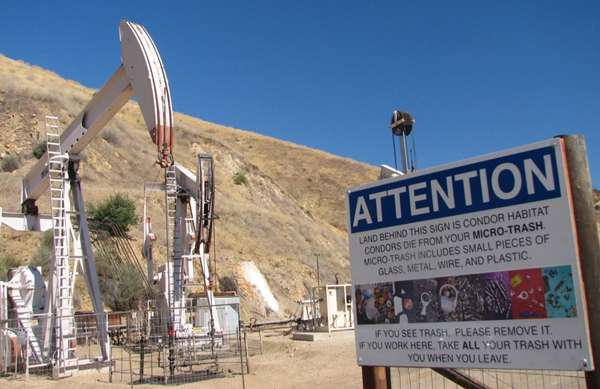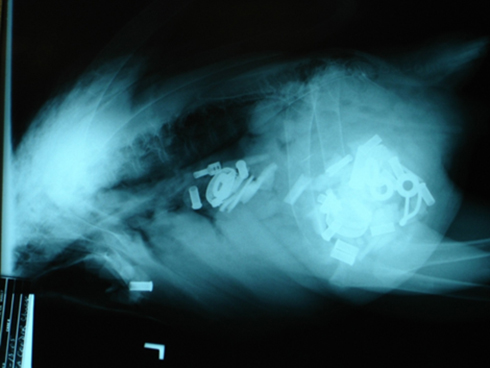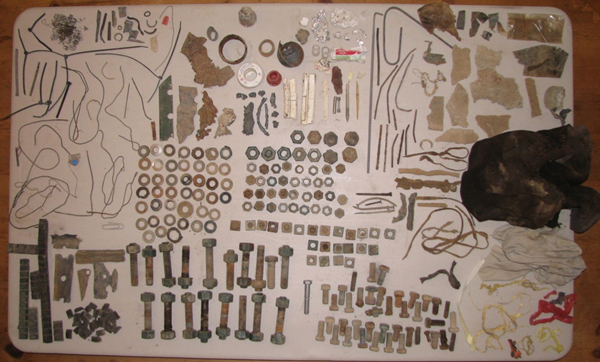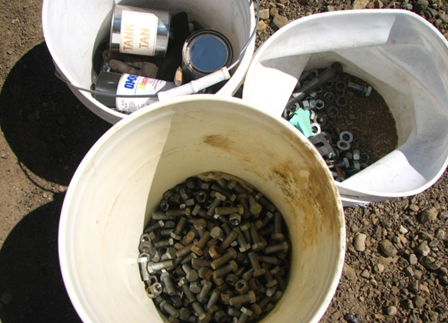A report released today by Los Padres ForestWatch reveals widespread trash contamination, toxic chemicals, and other hazards to wildlife in the Sespe Oil Field in and around the Los Padres National Forest. The findings suggest that the oil industry is not fulfilling its obligations to protect endangered California condors that live in the area, placing the entire California Condor Recovery Program at risk.

ForestWatch inspectors visited twelve oil pads in the Sespe Oil Field. Longstanding policies require oil companies to keep the pads clean of all trash.
Microtrash – broken glass, wire fragments, plastic bits, and other small fragments – is one of the leading causes of injury and death to California condors. Between 2001 and 2010, of the 29 California condor chicks hatched in the wild, 25 had microtrash in their digestive tracts, 10 died as a result, others were removed from the wild for recuperation, and two had emergency surgery and were eventually returned to the wild. According to federal biologists that manage California condor populations, microtrash is “one of the single most threatening challenges to condor recovery.”

A radiograph shows microtrash accumulated in the digestive tract of an endangered California condor. Photo courtesy USFWS.
One possible source of microtrash is garbage and debris left on oil well pads in the Sespe Oil Field, where condors are known to visit. Prime condor nesting and roosting areas are nearby, and the oil field is surrounded on three sides by the Sespe Condor Sanctuary and is adjacent to the Hopper Mountain National Wildlife Refuge. Because the oil field is located in prime condor habitat, oil companies operating in the Sespe Oil Field – and the government agencies that regulate them – have proposed numerous measures since 2005 to prevent the accumulation of microtrash on well pads.
To determine whether these measures are being effectively implemented, ForestWatch field inspectors recently conducted visits to twelve pads in the Sespe Oil Field, all operated by Seneca Resources. During these inspections, a total of 1,756 pieces of trash were collected from the twelve pads, for an average of 146 pieces per pad. ForestWatch inspectors also observed open containers of toxic fluids, condor strangulation hazards, and fragments of solder possibly containing lead, which is toxic to condors and other wildlife. Today’s report highlights the findings of these inspections.

ForestWatch inspectors collected a significant amount of microtrash from a single oil pad in the Sespe Oil Field.
“The Sespe Oil Field contains more than 150 pads, and our inspections suggest that all, or nearly all, of them contain significant amounts of microtrash and present significant hazards to condors and other wildlife,” concludes ForestWatch in the report. “The magnitude of this problem is staggering, and must be remedied immediately to ensure that condors are not harmed by ongoing activities in the Sespe Oil Field. Given the threat posed to condors by microtrash ingestion and contamination, current practices in the Sespe Oil Field are placing the entire California Condor Recovery Program at risk.”
The report recommends that Seneca and other oil companies, land managers, condor biologists, and nonprofit organizations work to inspect all pads in the Sespe Oil Field, to remove all microtrash that is currently present, and to quickly enact best management practices that will eliminate microtrash and other hazards from the area. ForestWatch will monitor the oil industry’s progress in addressing the report’s recommendations, and will hold the industry accountable to the highest standards in this ecologically sensitive area.

Open containers of microtrash were documented at several pads in the Sespe Oil Field.
Located approximately four miles north of Fillmore in Ventura County, the Sespe Oil Field is one of the oldest oil fields in California. Approximately half of the field’s oil and gas wells are located on land in the Los Padres National Forest. The other half are found throughout a patchwork of private land that is intermingled with the national forest land. The lands in and around the oil field provide important habitat for endangered California condors, including the Sespe Condor Sanctuary, the Hopper Mountain National Wildlife Refuge, and the Sespe Wilderness.
Download the report here,
and the full report (including Appendix) is available here.








Comments are closed.